In the face of escalating tariffs and trade tensions between China and the United States, the resilience of the Chinese manufacturing sector is noteworthy, particularly in the realm of custom cabinets. According to a report by the Cabinet Makers Association, the global cabinet market was valued at approximately $70 billion in 2021, with a significant share attributable to Chinese manufacturers who continue to innovate and adapt. Despite the challenges posed by tariffs, which were designed to curb imports, data suggests that Chinese exports of custom cabinets surged by 15% in the past year, highlighting an impressive capacity to withstand external pressures. This growth is not merely a statistic; it reflects the industry's commitment to quality craftsmanship and competitive pricing, making Chinese custom cabinets a preferred choice for buyers worldwide. As the trade landscape evolves, understanding the dynamics of this resilient sector becomes essential for stakeholders looking to navigate the complexities of international sourcing.

The resilience of Chinese manufacturing in the face of tariff pressures has been remarkable. Since the increase in tariffs imposed by the Trump administration, Chinese companies have implemented strategic internal reforms and supply chain restructurings to adapt to the new landscape. For instance, research shows that 72% of manufacturers in China have accelerated innovation and refined their operational frameworks to mitigate the impacts of tariffs. This proactive approach not only cushions against cost escalations but also enhances global competitiveness.
Tips for manufacturers looking to navigate these challenges include evaluating alternative sourcing strategies. Diversifying supply chains can reduce dependency on any single market; shifting some production to neighboring countries or regions can also minimize tariff impact. Another strategy is investing in automation and AI technologies, which can improve efficiency and reduce labor costs, ultimately offsetting potential increases from tariffs.
Furthermore, ongoing efforts by companies to localize production—similar to those seen in Taiwan's industrial sectors—are critical. By establishing a stronger foothold in North America and other markets, manufacturers can bolster their resilience against future trade disruptions, ensuring sustainable growth amidst evolving global trade dynamics.

In recent years, global supply chains have faced unprecedented challenges due to tariffs and trade tensions. These fluctuations have expedited a reevaluation of sourcing strategies across various industries. Companies reliant on international materials now find themselves navigating an intricate web of tariffs that can significantly impact production costs and delivery timelines. The manufacturing sector has been particularly adept at adapting to these changes, seeking alternative sources and optimizing their supply chains.
One notable trend is the rise of localized manufacturing, where businesses are shifting operations closer to home to mitigate tariff impacts. By investing in local production capabilities, companies not only reduce their exposure to international tariffs but also resonate with consumer preferences for locally-made products. This shift is particularly evident in the custom cabinets industry, which has seen an increase in the demand for high-quality, locally-manufactured options that align with consumer values of sustainability and craftsmanship. As manufacturers innovate and respond to the volatility of tariffs, their ability to remain agile will be crucial in maintaining a competitive edge in the evolving marketplace.
| Region | Industry | Tariff Rate (%) | Impact on Production (Estimated % Change) | Main Challenges |
|---|---|---|---|---|
| North America | Cabinet Manufacturing | 25 | 15 | Increased costs, supply disruption |
| Europe | Furniture | 10 | 5 | Regulatory compliance, tariff increases |
| Asia | Electronics | 20 | 10 | Supply chain delays, increased materials cost |
| South America | Automotive | 15 | 12 | Material shortages, fluctuating prices |
In the face of tariff challenges, the custom cabinet manufacturing sector is adapting and thriving through innovation and strategic shifts. Manufacturers are increasingly embracing advanced technologies to streamline production processes and enhance efficiency. For instance, the introduction of innovative fasteners has allowed companies to optimize their cabinet manufacturing, leading to increased sales and a more agile response to market demands.
Personalization is at the forefront of new retail strategies, shaping the way businesses interact with customers. Today’s consumers seek tailored experiences, and companies that can effectively cater to these preferences will stand out in a crowded marketplace. By implementing an effective personalization operating model, businesses can not only differentiate themselves but also build lasting customer loyalty.
Tips for manufacturers include focusing on innovation in production techniques to reduce costs while maintaining quality. Additionally, investing in understanding customer preferences through data analytics can provide insights that drive product development and marketing strategies. Finally, fostering a culture of adaptability within the organization will empower teams to embrace change and continually enhance the customer experience.
Amid the ongoing tariff challenges, Chinese manufacturing continues to showcase resilience, particularly in sectors such as custom cabinetry. According to recent market data, while China's retail sales showed a modest growth of 5.1% in April—just shy of the 5.5% forecast—it is evident that industrial output is holding steady despite the prevailing tariffs. This divergence points towards a robust manufacturing base that is adapting to external pressures.
Furthermore, China's Foreign Direct Investment (FDI) in Southeast Asia has seen significant growth as companies look to diversify their supply chains. This pivot highlights a strategic approach to mitigating risks associated with US tariffs, as manufacturers seek to maintain competitiveness without solely relying on the domestic market. Despite the expected economic impact of tariffs, currently estimated at a projected increase in average effective tariff rates, the adaptability of the manufacturing sector, particularly in custom cabinetry, reflects broader industry trends to innovate and thrive in challenging conditions.
China's manufacturing sector has shown remarkable resilience in the face of tariff challenges, particularly in the custom cabinetry market. As global trade dynamics shift, Chinese manufacturers are not only adapting to new regulations but are also leveraging their strengths—such as innovation, skilled labor, and advanced technologies—to maintain their competitive edge. The ability to pivot quickly has enabled many companies to continue delivering high-quality products, ensuring that they meet both domestic and international demand.
Looking to the future, sustaining this momentum will require strategic investments in automation and sustainability practices. As consumers increasingly prioritize eco-friendly products, manufacturers are integrating green technologies into their production processes. Additionally, fostering strong relationships with overseas partners can help mitigate the impact of tariffs, allowing for smoother operations and greater market access. By continually evolving and embracing change, China's manufacturing sector, particularly in custom cabinets, is positioned to thrive in an ever-changing global landscape.

Whether you’re a homeowner, builder, or designer, you’ll find that our elegant cabinets create a breathtaking space that evokes positive emotions and encourages lasting memories. We invite you to explore our website to learn more about who we are and how we can help you.
Woodinville | Bellevue | Seattle | Kirkland | California | Berkeley | Walnut Creek | Roseville, CA
© 2025 Acadia Craft. Powered by Integrity Marketing Serving Woodinville, Kirkland, Bellevue & The Greater Seattle Area
